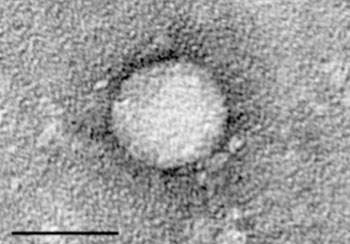Oxidized LDL Predicts Response to Interferon Treatment of Chronic Hepatitis C and May Be a Treatment Option
By LabMedica International staff writers
Posted on 28 May 2015
Oxidized low-density lipoprotein (oxLDL) in the blood was shown to predict responsiveness to interferon treatment in patients with chronic Hepatitis C virus (HCV) infection and to inhibit spread of the virus in vitro.Posted on 28 May 2015
HCV is a small enveloped virus with a single-stranded, positive-sense RNA genome. It has chronically infected an estimated 160 million individuals worldwide and is a leading cause of end-stage liver disease. Pegylated interferon-alpha (peg-IFN) in combination with ribavirin (RBV) has long been the standard treatment. Beginning in 2011 several direct-acting antiviral drugs (DAA) have been approved, and more are expected to follow. Currently, both peg-IFN-containing and interferon-free treatments are available.

Image: Electron micrograph of Hepatitis C virus purified from cell culture. Scale bar is 50 nanometers (Photo courtesy of the Center for the Study of Hepatitis C, the Rockefeller University).
Oxidized LDL is a modified form of low-density lipoprotein that is no longer a ligand for the native LDL receptor but is a ligand for the acetyl LDL receptor, and its uptake by macrophages is therefore much more rapid, sufficient to cause cholesterol accumulation and formation of the foam cells that block flow of blood in the arteries.
OxLDL has been shown to inhibit the interaction between HCV and several cell surface receptors, including scavenger receptor class B type I (SR-BI). Investigators at Hannover Medical School (Niedersachsen, Germany) tested whether serum oxLDL levels correlated with sustained virologic response (SVR) rates after interferon-based treatment of chronic hepatitis C.
To do this they determined baseline oxLDL in 379 participants with chronic HCV genotype 1 infection using a commercial enzyme-linked immunosorbent assay (ELISA). Mechanistic in vitro studies used full-length and subgenomic HCV genomes replicating in hepatoma cells.
Results published in the May 2015 issue of the journal Cellular and Molecular Gastroenterology and Hepatology revealed that oxLDL was found to be an independent predictor of SVR. Oxidized LDL did not correlate with markers of inflammation (alanine transaminase, ferritin), nor was serum oxLDL affected by exogenous interferon administration. Also, oxLDL did not alter the sensitivity of HCV replication to interferon. However, oxLDL was found to be a potent inhibitor of cell-to-cell spread of HCV between adjacent cells in vitro. It could thus reduce the rate at which new cells are infected by HCV through either the cell-free or cell-to-cell route. Finally, serum oxLDL was significantly associated with the estimated infected cell loss rate under treatment.
"While highly effective direct-acting antivirals have become the new standard of care for patients with hepatitis C, these treatments come with a hefty price tag," said first author Dr. Philipp Solbach, an internist at Hannover Medical School. "There may still be a role for the more affordable interferon-based therapies, and with this new information, we can better assess which patients will respond to this less-expensive treatment."
Related Links:
Hannover Medical School













